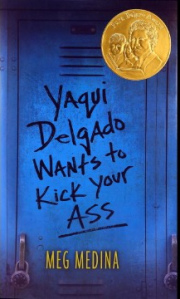 With four starred reviews and a Pura Belpré Award on the cover, I knew this would be a good book. What I didn’t realize is that I would stay up until 1:30 in the morning reading the last chapters, needing to know how everything turns out for Piddy Sanchez. This is a gritty, realistic, coming-of-age story that ultimately offers hope in the power of making our own choices in life.
With four starred reviews and a Pura Belpré Award on the cover, I knew this would be a good book. What I didn’t realize is that I would stay up until 1:30 in the morning reading the last chapters, needing to know how everything turns out for Piddy Sanchez. This is a gritty, realistic, coming-of-age story that ultimately offers hope in the power of making our own choices in life.
Publisher’s description: One morning before school, some girl tells Piddy Sanchez that Yaqui Delgado hates her and wants to kick her ass. Piddy doesn’t even know who Yaqui is, never mind what she’s done to piss her off. Word is that Yaqui thinks Piddy is stuck-up, shakes her stuff when she walks, and isn’t Latin enough with her white skin, good grades, and no accent. And Yaqui isn’t kidding around, so Piddy better watch her back. At first Piddy is more concerned with trying to find out more about the father she’s never met and how to balance honors courses with her weekend job at the neighborhood hair salon. But as the harassment escalates, avoiding Yaqui and her gang starts to take over Piddy’s life. Is there any way for Piddy to survive without closing herself off or running away? In an all-too-realistic novel, Meg Medina portrays a sympathetic heroine who is forced to decide who she really is.
* has reached a cross-roads and has important choices or decisions to make
* struggles with poverty, or needs to be introduced to someone who does
* is being raised by a single parent
* is exploring what it means to be part of a particular culture or to straddle more than one culture (Piddy is bullied by Yaqui in part because Yaqui doesn’t think she is “Latina enough.”)
* responds to a teen voice that is honest and unapologetic
Use this to discuss:
* Choices –Piddy has a slew of choices in front of her, and not one of them is easy. We see the choices that her friend Joey makes, and some of the choices that Yaqui makes. What choices does Piddy have in life? What are the ramifications of each? This would make for a good discussion, especially when paired with Steve Watkins’ young adult novel Juvie.
* Community–Although Piddy is being raised by her mother and has never met her father, she doesn’t lack for a support network. Lila, her mother’s friend, and the other ladies at the beauty salon where Lila works (and where Piddy works on the weekends) form a tightly-knit community that looks out for each other. Use Piddy’s story as a springboard to discuss various support systems that teens have in their lives.
* Point of View–Although we never get into Yaqui’s head, we get a glimpse of what her life must be like through Raul, a policeman who patrols Yaqui’s crime-ridden neighborhood, and Joey, Piddy’s friend and neighbor who lives with daily violence in his own home. Although Yaqui is the girl we want to hate, Meg Medina won’t let us, even though she keeps Yaqui’s point of view at arm’s length. How would Yaqui describe seeing Piddy for the first time? What bothers her so much about Piddy Sanchez?
* Bullying–One of the biggest choices Piddy must make is how to handle Yaqui’s bullying. Should she try to avoid Yaqui? Confront her? Tell an adult? This would make an excellent discussion starter about how to handle bullying and its lingering consequences.
Visit author Meg Medina’s website here, and read some sample chapters and see the string of honors this book has received here.
The Nitty Gritty~
Publisher: Candlewick Press
Publication Date: March 2013
ISBN-13: 978-0-7636-65859-5 (hardcover); 978-0-7636-7164-8 (paperback)
Number of Pages: 272
For ages 14 and up


 I was instantly drawn in by 13-year-old Theo (Theodora). She loses her beloved grandfather, Jack, in the very first chapter, leaving her alone with her dysfunctional, almost-always absent mother and not enough money to eat much more than Theo can grow in her backyard city garden. Yet Theo never feels sorry for herself, and neither does the reader. I admired her pluck and self-sufficiency, and gladly went along for the ride as Theo and her new (first ever?) friend, Bodhi, launch themselves into an adventure/mystery that kept me turning pages right up until the satisfying end. I’ll definitely be recommending this to my students in the fall.
I was instantly drawn in by 13-year-old Theo (Theodora). She loses her beloved grandfather, Jack, in the very first chapter, leaving her alone with her dysfunctional, almost-always absent mother and not enough money to eat much more than Theo can grow in her backyard city garden. Yet Theo never feels sorry for herself, and neither does the reader. I admired her pluck and self-sufficiency, and gladly went along for the ride as Theo and her new (first ever?) friend, Bodhi, launch themselves into an adventure/mystery that kept me turning pages right up until the satisfying end. I’ll definitely be recommending this to my students in the fall.

 Up next in my series on
Up next in my series on 


 This is the next book up in my series on
This is the next book up in my series on 